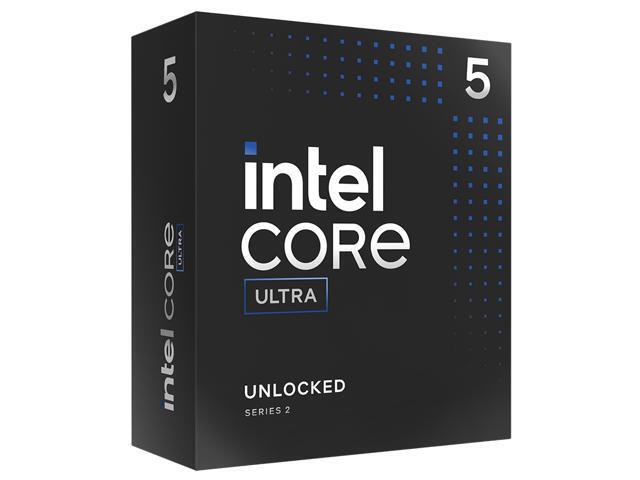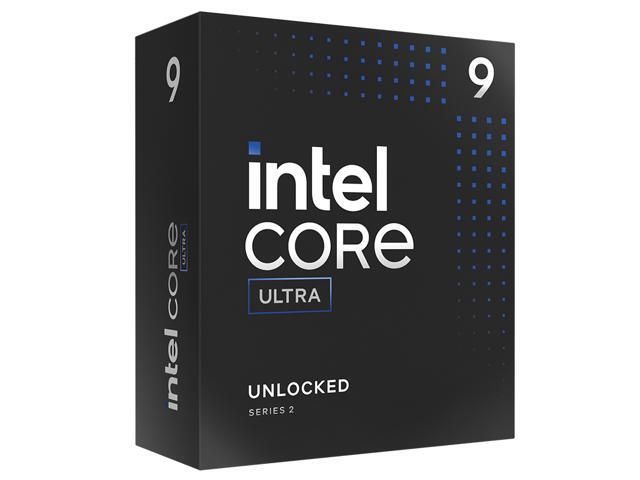Conclusion
Intel Core Ultra 200S Series CPUs are launching now, on October 24th, 2024. In our review today we have taken a good hard look at the new Intel Core Ultra 9 285K for $589 suggested eTail, and the Intel Core Ultra 5 245K for $309 suggested eTail pricing.
The Intel Core Ultra 9 285K is Intel’s flagship desktop CPU sporting 8 P-Cores and 16 E-Cores for up to 5.7GHz boost, with 24 cores and 24 threads for $589. Then, at the more affordable $309 range sits the Intel Core Ultra 5 245K desktop CPU sporting 6 P-Cores and 8 E-Cores at up to 5.2GHz, with 14 cores and 14 threads. These CPUs are based on new Lion Cove P-Cores and Skymont E-Cores and use Intel’s new disaggregated tiled architecture with Intel packaging several tiles in their design.
How Do They Compare
In our performance testing today, we benchmarked the CPUs in several different workloads to look at multi-core/multi-thread performance and single-core/single-thread performance. We included gaming performance, using in-game manual run-throughs in 8 games.
We also tested the Arrow Lake CPUs in the “Balanced” Windows Power Mode profile and “Best Performance” due to the performance differences we experienced. This allowed us to give a comprehensive look at performance, and we also included the 14900K in the BIOS Extreme and Performance profiles as well.
If you are looking at the Intel Core Ultra 5 245K compared to the AMD Ryzen 5 9600X, it is clear that the new Intel Core Ultra 5 245K will offer substantially better multi-core performance. It may be the better CPU if you do workloads that require many cores, or you do a lot of multi-tasking. However, for gaming, the opposite is true. The AMD Ryzen 5 9600X is a much better, and more consistent, CPU for gaming with no thread scheduling issues thanks to its single-CCD nature.
The waters become more murky when you throw the AMD Ryzen 7 9700X into the comparison. It does do much better in multi-core performance a lot of the time and also has great success in allowing consistent gameplay performance with its single-CCD nature, i.e., no thread scheduling issues.
Either way, the 9600X and 9700X are the better CPUs for gaming performance, than the Intel Core Ultra 5 245K. For multi-threading, the 245K is better than the 9600X, but the 9700X challenges the 245K since it can do well in multi-threading and performs great in games, giving you both options.
If you are looking at the Intel Core Ultra 9 285K compared to the AMD Ryzen 9 9950X, you basically have to figure out what your main workloads will be. Overall, the Ryzen 9 9950X seems to offer great single-core/single-thread performance, and this can help a lot of office or productivity/multi-tasking workloads.
That said, in the right scenario the Intel Core Ultra 9 285K can do quite well in multi-threading performance, but in the right workloads. Because the Ryzen 9 9950X is better in single-core/single-thread performance it is also the better gaming CPU, even though it is a dual-CCD design. There are many inconsistencies with the Intel Core Ultra 9 285K when it comes to the gaming experience.
Power
In terms of power, the new Intel Core Ultra 9 285K does utilize less power than the previous generation, improves upon that design, and runs much cooler. The most impressive in this area is the Intel Core Ultra 5 245K, which does have noticeable power savings and temperature reduction.
In comparison to the competition, the AMD Ryzen 9000 CPUs (Zen 5) are overall more power efficient for the performance delivered. While the Intel Core Ultra 9 285K and Core Ultra 245K do use less power, they are also less performant in many scenarios compared to the previous generation. The AMD Ryzen 9000 series CPUs maintain this power efficiency and deliver performance as well.
Windows 11 Power Profile
Quite honestly, we are baffled as to why the Windows 11 Power Mode profile option is affecting single-core/single-thread performance so much. We would understand multi-core performance, and perhaps the CPU hitting a power cap, but that shouldn’t be the case in single-thread workloads. However, as a result of this degradation in performance gaming performance is drastically reduced in the Windows default “Balanced” Power Mode profile.
This is not typical on the previous Raptor Lake platform, or the AMD Ryzen/Zen 4 and 5 platform. As you can see in our testing, the performance of those parts on the default “Balanced” Power Mode profile is quite good, and as expected. In fact, AMD recommends “Balanced” for the best performance, this was heavily made clear during the Zen 5 launch when performance results were all over the place with that one. In fact, in Intel’s reviewer’s guide, Intel states this: “We generally leave operating system settings at their defaults as a typical end user will most likely not alter these settings.”
Our testing today has indicated that “Balanced” will show degraded performance on Arrow Lake CPUs. For comparison sake, we were also able to run a test between “Balanced” and “Best Performance” in Windows 11 23H2, and we experienced the same behavior, causing a performance difference in PCMark between the power settings. Therefore, this is a thing that is not restricted to the new 24H2 version of Windows. Users should be aware of this if you want the most potential out of your new Arrow Lake CPU.
Final Points
Much like AMD Zen 5, Arrow Lake may look better as it matures over time. BIOS updates to refine microcode, software updates, and perhaps Windows updates to refine thread management could occur, and we hope they do. With some maturity, Arrow Lake can be competitive, and with maturity can hopefully show its full potential.
When thread scheduling works well across the P-Cores and E-Cores, performance is competitive, but when it does not, then it suffers, and sadly Windows is terrible at managing this currently. Game performance can really suffer when game threads are thrown over to the E-Cores, and switch between P and E-Cores frequently, sadly, this happens, and the gaming experience is diminished because of it.
- Thread Scheduling Issues – There are potentially thread scheduling issues, or latency issues, causing performance variances, and inconsistencies. The result is degraded gaming performance and potentially odd application performance in certain Windows power modes.
- Frequency Reduction – The boost frequencies being lowered this generation seem to harm single-core/single-thread performance overall. The result of this is degraded gaming performance and certain day-to-day workloads that benefit from single-core boosts, or lightly threaded applications.
- Competitive Multi-Threading Performance – Arrow Lake can have competitive multi-core/multi-thread performance compared to the competition, it actually does quite well in this area despite not having SMT/Hyperthreading.
- Not Your Gaming CPU – Arrow Lake is not built well for gaming performance. The result is inconsistent gaming experience, and degradation in gaming performance due to single-core/thread and frequency. There are options from the competition, in the form of X3D 3D V-Cache parts if gaming is your goal.
- Intel Core Ultra 5 245K – Compared to the competition’s 9600X, the Core Ultra 245K is a worthy competitor specifically to that CPU given the pricing segments, and multi-thread performance offered on the 245K.
Are the Intel Core Ultra 9 285K and Intel Core Ultra 5 245K good CPUs? The CPUs have their place, for the right dollar amount. The Intel Core Ultra 9 285K and Core Ultra 5 245K are not bad multi-core/multi-thread performing CPUs, in fact, this is their strong suit. If you require workloads that are multi-threaded or do content creation, video rendering, or 3D rendering, they can be appealing for those tasks. What will be challenging will be new AMD holiday promotions that have been announced, which could eventually just become the norm in pricing. If that’s true, then the battle is very strong and there’s a hard road ahead for Arrow Lake.








